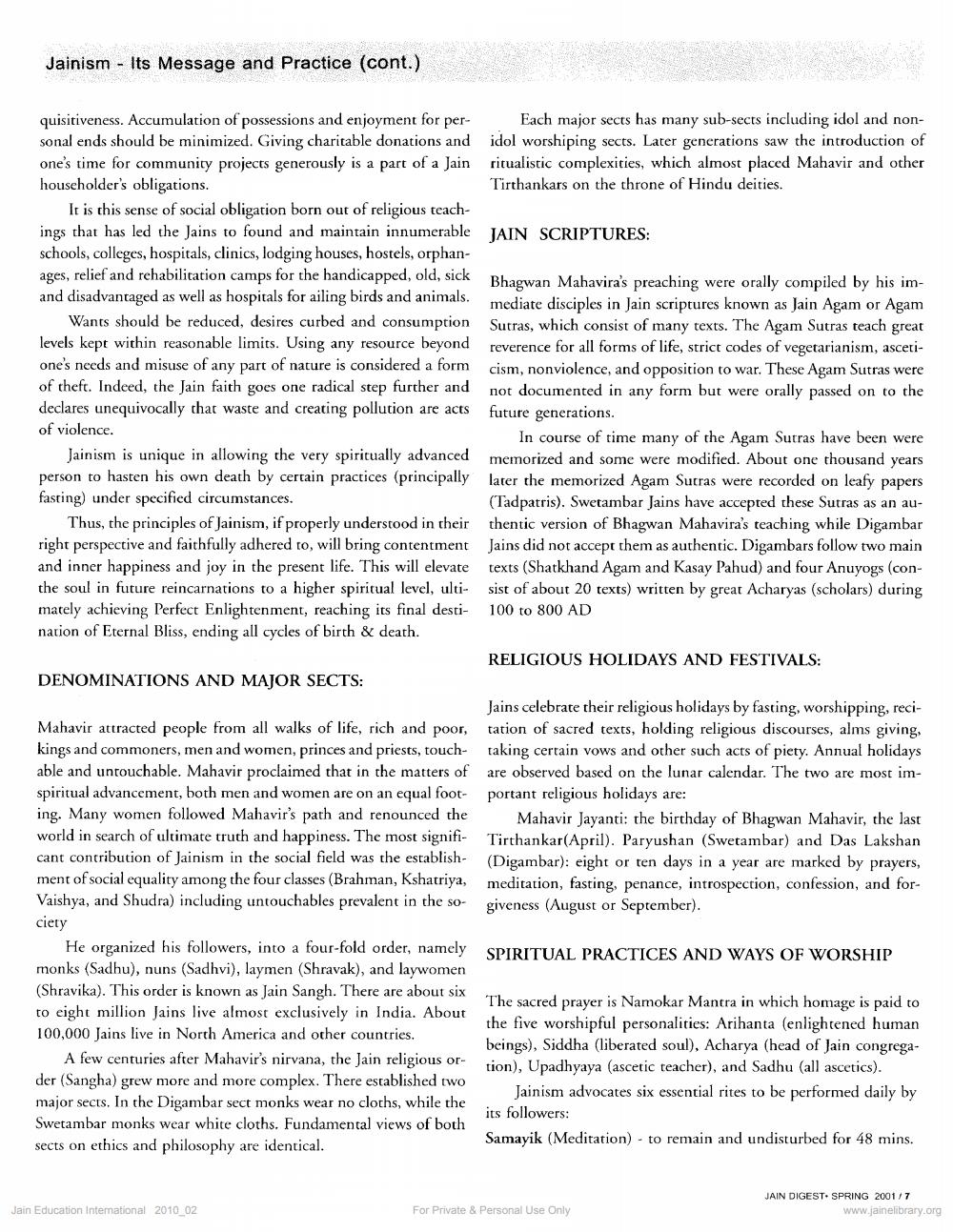Book Title: Jain Digest 2001 01 Vol 17 No 01 Author(s): Federation of JAINA Publisher: USA Federation of JAINA View full book textPage 9
________________ Jainism - Its Message and Practice (cont.) quisitiveness. Accumulation of possessions and enjoyment for personal ends should be minimized. Giving charitable donations and one's time for community projects generously is a part of a Jain householder's obligations. It is this sense of social obligation born out of religious teachings that has led the Jains to found and maintain innumerable JAIN SCRIPTURES: schools, colleges, hospitals, clinics, lodging houses, hostels, orphanages, relief and rehabilitation camps for the handicapped, old, sick and disadvantaged as well as hospitals for ailing birds and animals. Wants should be reduced, desires curbed and consumption levels kept within reasonable limits. Using any resource beyond one's needs and misuse of any part of nature is considered a form of theft. Indeed, the Jain faith goes one radical step further and declares unequivocally that waste and creating pollution are acts of violence. Jainism is unique in allowing the very spiritually advanced person to hasten his own death by certain practices (principally fasting) under specified circumstances. Thus, the principles of Jainism, if properly understood in their right perspective and faithfully adhered to, will bring contentment and inner happiness and joy in the present life. This will elevate the soul in future reincarnations to a higher spiritual level, ultimately achieving Perfect Enlightenment, reaching its final destination of Eternal Bliss, ending all cycles of birth & death. DENOMINATIONS AND MAJOR SECTS: Mahavir attracted people from all walks of life, rich and poor, kings and commoners, men and women, princes and priests, touchable and untouchable. Mahavir proclaimed that in the matters of spiritual advancement, both men and women are on an equal footing. Many women followed Mahavir's path and renounced the world in search of ultimate truth and happiness. The most significant contribution of Jainism in the social field was the establishment of social equality among the four classes (Brahman, Kshatriya, Vaishya, and Shudra) including untouchables prevalent in the society Each major sects has many sub-sects including idol and nonidol worshiping sects. Later generations saw the introduction of ritualistic complexities, which almost placed Mahavir and other Tirthankars on the throne of Hindu deities. A few centuries after Mahavir's nirvana, the Jain religious order (Sangha) grew more and more complex. There established two major sects. In the Digambar sect monks wear no cloths, while the Swetambar monks wear white cloths. Fundamental views of both sects on ethics and philosophy are identical. Jain Education International 2010_02 Bhagwan Mahavira's preaching were orally compiled by his immediate disciples in Jain scriptures known as Jain Agam or Agam Sutras, which consist of many texts. The Agam Sutras teach great reverence for all forms of life, strict codes of vegetarianism, asceticism, nonviolence, and opposition to war. These Agam Sutras were not documented in any form but were orally passed on to the future generations. In course of time many of the Agam Sutras have been were memorized and some were modified. About one thousand years later the memorized Agam Sutras were recorded on leafy papers (Tadpatris). Swetambar Jains have accepted these Sutras as an authentic version of Bhagwan Mahavira's teaching while Digambar Jains did not accept them as authentic. Digambars follow two main texts (Shatkhand Agam and Kasay Pahud) and four Anuyogs (consist of about 20 texts) written by great Acharyas (scholars) during 100 to 800 AD RELIGIOUS HOLIDAYS AND FESTIVALS: Jains celebrate their religious holidays by fasting, worshipping, recitation of sacred texts, holding religious discourses, alms giving, taking certain vows and other such acts of piety. Annual holidays are observed based on the lunar calendar. The two are most important religious holidays are: He organized his followers, into a four-fold order, namely SPIRITUAL PRACTICES AND WAYS OF WORSHIP monks (Sadhu), nuns (Sadhvi), laymen (Shravak), and laywomen (Shravika). This order is known as Jain Sangh. There are about six to eight million Jains live almost exclusively in India. About 100,000 Jains live in North America and other countries. Mahavir Jayanti: the birthday of Bhagwan Mahavir, the last Tirthankar (April). Paryushan (Swetambar) and Das Lakshan (Digambar): eight or ten days in a year are marked by prayers, meditation, fasting, penance, introspection, confession, and forgiveness (August or September). The sacred prayer is Namokar Mantra in which homage is paid to the five worshipful personalities: Arihanta (enlightened human beings), Siddha (liberated soul), Acharya (head of Jain congregation), Upadhyaya (ascetic teacher), and Sadhu (all ascetics). Jainism advocates six essential rites to be performed daily by its followers: Samayik (Meditation) - to remain and undisturbed for 48 mins. For Private & Personal Use Only JAIN DIGEST SPRING 2001/7 www.jainelibrary.orgPage Navigation
1 ... 7 8 9 10 11 12 13 14 15 16 17 18 19 20 21 22 23 24 25 26 27 28 29 30 31 32 33 34 35 36 37 38 39 40 41 42 43 44 45 46 47 48 49 50 51 52 53 54 55 56
